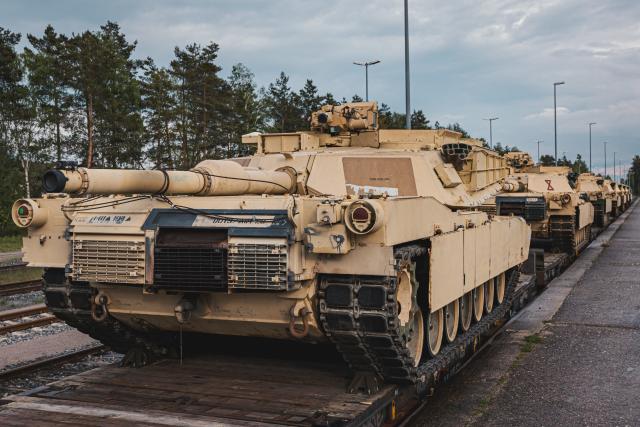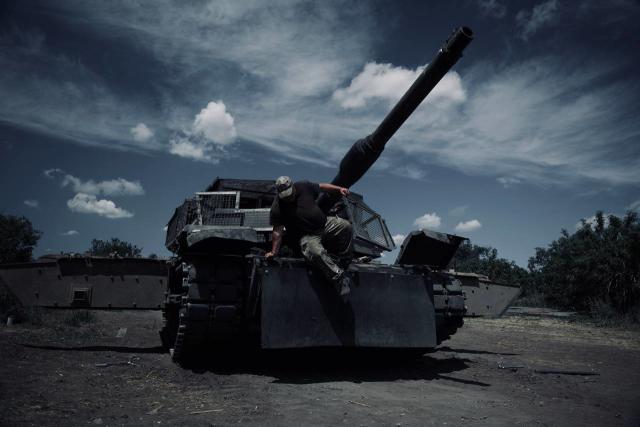
- Ukraine has been operating a small number of US-made M1A1 Abrams tanks.
- These tanks are heavily armored, but they are still vulnerable to Russian threats, including drones.
- An Abrams commander said that the tanks would benefit from more dynamic protection on the exterior.
US-made Abrams tanks in operation with the Ukrainian military are facing an unfamiliar battlefield compared to their previous wars, as Russia uses small drones rigged with explosives to threaten armored vehicles below.
The highly advanced M1A1 Abrams tanks have been equipped with electronic warfare capabilities to help keep these drones away. However, a Ukrainian tank commander says these heavily armored machines still need more exterior protection to help them defend against incoming munitions that come through.
In service of this mission, some of Ukraine’s Abrams have been spotted with added cage armor and explosive reactive armor tiling to help better shield the tanks.
“It can save a life,” the commander, who goes by the call sign Zakon, said through a translator during a recent interview with Business Insider from an undisclosed location near the front lines in eastern Ukraine.
Last fall, the US sent Ukraine 31 older Abrams Variants,which are in service with the country’s battle-hardened 47th Mechanized Brigade. Kyiv has since lost several of these main battle tanks — some estimates suggest as many as 10 — but the remainder are very much in operation and were actually just in combat.
Facing new and old threats
Zakon commands a single Abrams tank and oversees a crew that consists of a driver, a loader, and a gunner. He praised his $10 million Abrams as a major upgrade over the Soviet-era tanks, like the T-72 or T-64, that Ukraine had at the start of the war. However, he noted they are still vulnerable to many Russian threats,especially the small exploding drones.
First-person view (FPV) drones, often small quadcopter-style remotely piloted systems, have dominated the battlefield in Ukraine. Both sides have used these systems, which are cheap and abundant, to deliver precision strikes on troops, equipment, positions, and armored vehicles.
Zakon said that Russian FPV drones are a huge threat to the Abrams. They have targeted his tank on several occasions, including in swarms, where multiple drones attack at the same time.
One such attack occurred last month. The crew, he said, relied on the tank’s newly made anti- drone protective screen, donated by Rinat Akhmetov’s Steel Front initiative, and its electronics warfare capabilities — which jams the signal connecting the operator to the drone — to narrowly avoid catastrophe.
In another incident, the tank driver managed to stop the Abrams just in time before an exploding FPV drone struck directly in front of it. Zakon said the tank’s electronic warfare capabilities and the explosive reactive armor it was equipped with at the time helped curb the attack, preventing it from worsening.
The threat doesn’t end with drones, though. Zakon said that the Abrams are “easy targets” for weapons that are rather prolific on the battlefield, like anti-tank missiles and rocket launchers.

Zakon said the Abrams are durable and “can withstand a hit.” But he stressed that Ukraine still needs more protection, specifically dynamic systems like the Abrams Reactive Armor Tile, ARAT-1, or the Soviet Kontakt-1 options. This technology helps defend the tank from explosives.
The crew “will be motivated to perform better when they know that there is this kind of protection,” Zakon said. “It’s really, really important.”
A need for more tanks
Beyond the threats, availability has been another challenge. Despite the tremendous hype surrounding the delivery of the Abrams, the small number of tanks that Ukraine actually received has made them more precious and less expendable than the other US-made armor Kyiv got, like the Bradley fighting vehicle.
Ukrainian President Volodymyr Zelenskyy said last week that he didn’t think such a limited number of tanks could make a difference on the battlefield. Speaking on the sidelines of the NATO summit in Washington, DC, he warned Kyiv could face this same problem with F-16 fighter jets finally on their way. There may simply not be enough.
The Abrams was designed with the Soviet armor threat in mind in a time before exploding drones were ever even an idea and were specifically built to kill other tanks and execute massive armored assaults, which is how the US military traditionally used the machines in conflicts like those in the Middle East. In the Gulf War, for instance, it earned a fearsome reputation.

But the Abrams aren’t used in Ukraine for armored breakthroughs. Rather, Kyiv relies on them more to support and strengthen its positions, including the movement of infantry troops, vehicles, and equipment. The Bradley has proven particularly useful for this mission.
Zakon said that one of the best things about the Abrams tank is its speed — according to the available information, it can travel up to 45 miles an hour — and how easy it is for the roughly 60-ton combat vehicle to move into and out of battle.
In combat, the tanks have been “worked to their maximum” and inflicted damage on Russian forces. However, he said Ukraine still needs more vehicles and personnel to operate them to help with assaults on Russian positions.
He also emphasized that more protection would help keep his fellow soldiers safe.
“These are really well-trained people,” Zakon said of Ukraine’s tank crews. “That’s why we need to do everything possible to ensure that we have this kind of dynamic protection so that we can save lives.”



